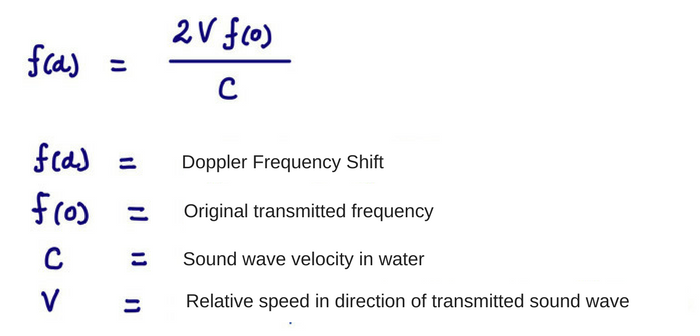

Substituting this into the Doppler effect formula, we get the equation of the Doppler effect when a source moves towards an observer at rest-į L = \(\frac \)) 1437.54 In this case, the velocity of the observer velocity is zero, so v o is equal to zero.

 f s is the frequency of sound emitted by the source (Hz, or 1/s)ĭoppler Effect Formula a) Source Moving Towards the Observer at Rest. v s is the velocity of the sound source (in m/s). v is the speed of sound in the medium (in m/s). f L is the frequency of sound that the listener perceives (Hz, or 1/s). (1 Hz = 1s -1 = 1 cycle/s).Īs a result, the formula for the doppler effect is: The Doppler effect occurs when a source of waves and/or observer move relative to each other, resulting in the observer measuring a different frequency of the. The frequency of the sound is measured in Hertz (Hz) where one Hertz is one cycle per second. blue shift the distance between source and observer is decreasing. When the listener and the source get near enough, the frequency heard by the listener is higher than the sound produced by the source. When the listener and the source moves away from each other, the frequency heard by the listener is lower than the frequency heard by the source. The relative velocity u of the source and observer for motion towards each other determines the Doppler shift for light. red shift the distance between source and observer is increasing. If the source of the sound and the listener move in relation to each other, the sound heard by the listener changes. The most common analogy of this is standing on the side of the. Read More: Coherent and Incoherent Addition of Waves A Doppler shift is a phenomenon of a change in frequency based on the observers point of view. Doppler effect is known to our encounters with sound waves. The Doppler effect may be seen in any wave type, including water waves, sound waves, and light waves. It is crucial to note that the impact isn't caused by a change in the source's frequency. Explore the Doppler effect and discover the formula for calculating observed.
f s is the frequency of sound emitted by the source (Hz, or 1/s)ĭoppler Effect Formula a) Source Moving Towards the Observer at Rest. v s is the velocity of the sound source (in m/s). v is the speed of sound in the medium (in m/s). f L is the frequency of sound that the listener perceives (Hz, or 1/s). (1 Hz = 1s -1 = 1 cycle/s).Īs a result, the formula for the doppler effect is: The Doppler effect occurs when a source of waves and/or observer move relative to each other, resulting in the observer measuring a different frequency of the. The frequency of the sound is measured in Hertz (Hz) where one Hertz is one cycle per second. blue shift the distance between source and observer is decreasing. When the listener and the source get near enough, the frequency heard by the listener is higher than the sound produced by the source. When the listener and the source moves away from each other, the frequency heard by the listener is lower than the frequency heard by the source. The relative velocity u of the source and observer for motion towards each other determines the Doppler shift for light. red shift the distance between source and observer is increasing. If the source of the sound and the listener move in relation to each other, the sound heard by the listener changes. The most common analogy of this is standing on the side of the. Read More: Coherent and Incoherent Addition of Waves A Doppler shift is a phenomenon of a change in frequency based on the observers point of view. Doppler effect is known to our encounters with sound waves. The Doppler effect may be seen in any wave type, including water waves, sound waves, and light waves. It is crucial to note that the impact isn't caused by a change in the source's frequency. Explore the Doppler effect and discover the formula for calculating observed. 
As for the observers from whom the source is receding, a downward shift in frequency will be observed. The Doppler effect is the observed change in the frequency of waves as the source of the waves passes by the observer.
Therefore, the frequency of the sound of the train’s horn which the driver will hear is 488.2 Hz. When the source of the sound waves is moving towards the observer, an upward shift in frequency is observed. Thus, we will arrange the value in the Doppler Effect Formula to find out the frequency which is: f L fs.When the source and the observer move relative to each other, the frequency that is observed by the observer (f a) is different from the actual frequency that is produced by the source (f 0). The mathematical formulation of Doppler effect for an object moving with the velocity much less than that of light is pretty straight forward.The Doppler effect is a phenomenon caused by a moving wave source that causes an apparent upward shift in frequency for observers who are approaching the source and a visible downward change in frequency for observers who are retreating from the source. The Doppler Effect, also known as the Doppler shift, is the result of a change in the frequency of sound waves caused by movement. Doppler Effect: Have you ever wondered that when a whistling train is approaching a railway crossing, the pitch of its whistle keeps on increasing, and when.








 0 kommentar(er)
0 kommentar(er)
